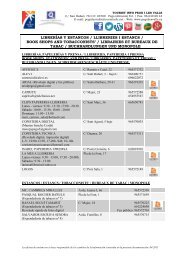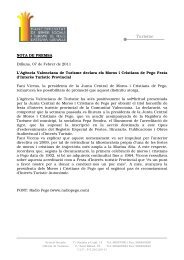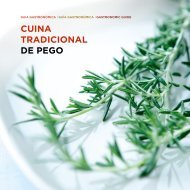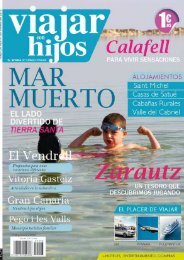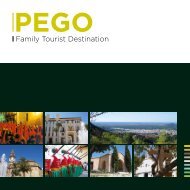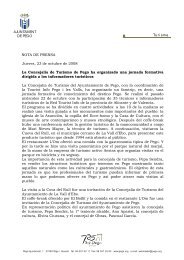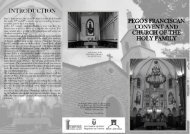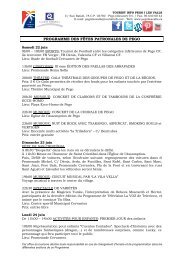subregion
Create successful ePaper yourself
Turn your PDF publications into a flip-book with our unique Google optimized e-Paper software.
introduction<br />
Pego, Adsubia and les Valls, linked by their mountains and<br />
valleys, and by historical and social bonds, form a <strong>subregion</strong><br />
within the Marina Alta that offers an alternative form<br />
of tourism.<br />
A number of villages are located in this area whose inhabitants<br />
through the ages have made a living from traditional farming<br />
adapted to the conditions of the land where the Moorish past<br />
is evident in every corner.<br />
Use your ive senses to enjoy this wonderful scenery that is a<br />
relection of the unique character of our villages.<br />
MARINA<br />
ALTA
how to get there<br />
From the north: Exit from the AP-7<br />
motorway at junction number 61 “Oliva-<br />
Pego”. Continue to Oliva on the N-332<br />
main road. Drive through the town and<br />
turn right at the junction signposted Pego<br />
on the CV-700 road or continue on the<br />
N-332 for a few kilometres and take the<br />
second turning to Pego from which you<br />
can enjoy the marvellous scenery of the<br />
Pego-Oliva Marshlands Nature Park.<br />
From the south: Exit from the AP-7<br />
motorway at junction number 62 “Ondara-<br />
Dénia-Jávea”. Continue towards Valencia<br />
on the N-332 main road. Then take the CV-<br />
700 to Pego (11 km).<br />
If you are travelling from the inland regions<br />
you turn off the N-340 in Muro de Alcoy<br />
and take the CV-700 road “La Vall de<br />
Gallinera – Pego”.<br />
From Benidorm you can take the scenic<br />
CV-715 inland route.
PEGO<br />
i<br />
Population: 11043 inhabitants (Año 2008)<br />
Area: 52,50 km²<br />
Town Hall: Tel. 96 557 00 11<br />
Fax 96 557 25 83<br />
Web: www.pego.org<br />
festivities<br />
17th January: Rpilgrimage to hermitage<br />
dedicated to Saint Anthony (in Spain patron<br />
Saint of the animals).<br />
The last Saturday but one before the beginning<br />
of lent: In other words, the Saturday before the<br />
Pego Carnival, the “Descenso del río Bullent”<br />
(race down the river in homemade boats).<br />
Saturday before Ash Wednesday: Gran Desile de<br />
Disfraces” (fancy dress parade).<br />
Saturday after Carnival: “Pinyata” or “Entierro de<br />
la Sardina” (Sardine’s burial).<br />
17th, 18th and 19th March: “Fallas” (huge<br />
colourful monuments made of “papier mâché”)..<br />
April: Holy Week.<br />
At the end of June: The Moors and Christians, with<br />
the feast of the Holy Ecce-Homo, patron of Pego.<br />
monuments<br />
THE ASSUMPTION CHURCH: (16th-17th century):<br />
Inside the building you can see the<br />
“Retablo de la Esperanza” altarpiece of International<br />
Gothic style, the double Veronica<br />
and the Christ of the Sacristy, all dating<br />
from the 15th century. The Bell Tower was<br />
built later, in 1700.<br />
THE ECCE-HOMO CHAPEL: This is without<br />
doubt Pego’s most emblematic monument.<br />
It dates from the baroque period<br />
(1776). In the interior of the chapel you can<br />
see the 16th century Ecce-Homo, venerated<br />
as the towns patron. Long ago this building<br />
was used as a hospital and also gave<br />
shelter to travellers and pilgrims.<br />
THE CULTURE CENTRE: In past times the stately<br />
home of the inluential Torres-Sala family.<br />
This magniicent house was build in the 18th<br />
century and its interior patio preserves a<br />
piece of the ancient wall, declared “Bien<br />
de Interés Cultural” or national heritage. In<br />
this building you will ind the Public Library,<br />
the Assembly Hall, the Historical Archives,<br />
the Modern Art Exhibition Hall, the Ethnological<br />
Museum (about the rice crop and<br />
traditional trades), and the “Juan Torres<br />
Sala” Entomological Collection.<br />
THE “PORTAL DE SALA” GATE: This is the last<br />
remaining of Pego’s three ancient gates. In<br />
medieval times the “Portal de Sala” gave<br />
access to the vegetable gardens.<br />
THE FRANCISCAN CONVENT: This monastery<br />
was built at the end of the 19th century.<br />
THE SAINT ANTHONY HERMITAGE: Built during<br />
the reign of Felipe II to attend the spiritual<br />
needs of the Moors that converted<br />
to the Catholic faith. Its architecture is<br />
typical of the so called “hermitages of the<br />
conquest”.<br />
THE AMBRA CASTLE: The construction of this<br />
fortress started in the second half of the<br />
12th century.
gastronomy<br />
Rice forms part of the staple diet. One of the<br />
most typical meals is “la Crosta” (a rice dish<br />
cooked in the oven with an egg crust) and<br />
also “arroz caldoso” (rice stew), “arroz con<br />
habichuelas y pencas” (rice with kidney beans<br />
and Swiss chard) and paella.<br />
Specially tasty are the “espencat” (a delicious<br />
cold dish of baked peppers, aubergines and<br />
tomatoes, seasoned with olive oil and a touch<br />
of crushed garlic), the “igatells” (grilled lat<br />
meatballs), “cocas escaldadas” and the<br />
“cocas al horno”, the small pizza-like savoury<br />
topped lat breads that every Thursday -market<br />
day in Pego- are on sale in the local bread and<br />
cake shops.<br />
There is also a great variety of traditional buns<br />
and pastries such as the “la mona” typical at<br />
Easter and the sweet potato pastries and the<br />
fritters that are eaten at Christmas.
PEGO-OLIVA MARSHLANDS<br />
Area: 1 290 Ha.<br />
Information Centre: 96 640 02 51<br />
Email: parque_pegooliva@gva.es<br />
Web: http://parquesnaturales.gva.es/espnaturales.htm<br />
How to get there:<br />
CV-715 Pego-Oliva, take the turning towards the Bullentó.<br />
CV-678 Pego-Les Deveses, crosses through the nature park.<br />
CV-700 Pego-El Verger, from the south.<br />
i
This marshland was declared “Parque Natural” (regional<br />
nature reserve) in 1994.<br />
The “Marjal de Pego-Oliva” is situated at the south of the<br />
gulf of Valencia and is one of the most important biodiversity<br />
areas of the Mediterranean coast. It is perhaps the most<br />
important wet zone of the Spanish Mediterranean coast.<br />
It is fed by the waters of the Bullent-Vedat rivers in the<br />
north and the Racons-Molinell rivers in the south and by<br />
the Mostalla and Segaria aquifers. A network of ancient<br />
irrigation ditches and canals transport water from<br />
underground sources through the marsh.<br />
It is the habitat of numerous species of ish and aquatic birds,<br />
many of them protected, such as the Valencia hispanica,<br />
the tiny ish know locally as the “samaruc” or the purple<br />
gallinule, an uncommon wader that prefers reed beds.<br />
It is important to point out that the balance between the<br />
traditional rice growing and respect for the environment<br />
had allowed the survival of numerous species of lora and<br />
fauna of top biological interest.<br />
The increase of animal species has occurred at the same<br />
time that local varieties of rice such as “bombón” and<br />
“pegolí” have been recuperated.<br />
In July and August boat rides take place in the Salinar area<br />
allowing marvellous views of the marshland scenery and<br />
sightings of interesting birds.
LA VALL D’EBO<br />
Population: 299 inhabitants (Año 2008)<br />
Area: 32,43 km²<br />
Town Hall:<br />
Tel. 96 557 14 13 ∙ Fax 96 557 26 72<br />
Web: www.lavalldebo.org<br />
i<br />
places of interest<br />
“COVA DEL RULL”: stalactite and stalagmite cave. This<br />
cave was discovered in 1919 by José Vicent Mengual,<br />
nicknamed “tío Rull”.<br />
THE ETHNOLOGICAL MUSEUM: there the visitor can discover<br />
the past: clothes, ornaments, farming tools... and try to<br />
recreate the life of the former inhabitants of the valley.<br />
THE SAN MIGUEL CHURCH: from the baroque period, it was<br />
built in 1623, and houses the wonderful “Mare de Déu dels<br />
Desemparats” sculpting, from the Vergara school.<br />
“TOLLS”: The Ebo river has sculptured the rock to form<br />
natural pools.<br />
“AVENCS”: funnel shaped abysses formed in the rock:<br />
- The “Avenc ample” (wide), it reaches a depth of 56<br />
metres and a width of 20 metres.<br />
- The “Avenc d’enmig” (central), with a depth of 120<br />
metres.<br />
- The “Avenc ample” (narrow), it reaches a depth of 137<br />
metres.<br />
“BARRANC DE L’INFERN” (or Hell’s Ravine): it is a narrow<br />
gorge with vertical walls which has a climber’s route<br />
towards the middle and end part reserved exclusively for<br />
experts mountaineers. The “Font del Xili” spring is located<br />
in the entrance to the gorge.<br />
THE “COVA DEL REINÓS”: cave also known as the “Cova<br />
de les Torrudanes” can be found Levantine cave<br />
paintings.
gastronomy<br />
The best known dishes of this valley<br />
are the “puchero” (stew) and rice<br />
with beans.<br />
festivities<br />
Fiestas in honour of the “Mare de<br />
Déu dels Desemparats”. in the irst<br />
weekend of August.<br />
The San Miguel iesta, it takes place<br />
with the traditional pilgrimage to the<br />
Cova del Rull. It is in the last week of<br />
September..
LA VALL D’ALCALÀ<br />
Population: 186 inhabitants (Año 2008)<br />
Area: 23,70 km²<br />
Town Hall Alcalà de la Jovada:<br />
Tel. 96 551 43 00<br />
Fax 96 551 41 07<br />
Web: www.lavalldalcala.es<br />
i<br />
monuments<br />
“NEVERAS” (ice caves): The Baix or lower<br />
cave can be found beside the CV-712<br />
road between Alcalá and Ebo. They were<br />
constructed in the17th century in order to<br />
provide the port of Denia with a supply of ice.<br />
RUINS OF THE MOORISH VILLAGES: L’Atzuvieta<br />
is considered the largest and best preserved<br />
Moorish village of the Valencian Community<br />
and offers an almost unique example of the<br />
evolution of the rural Moslem architecture. You<br />
can also visit La Roca and La Caerola.<br />
THE CHURCH OF ALCALÀ: 17th<br />
century, built over the mosque.<br />
Today a terrace of houses next to<br />
the church stands on what used to<br />
be the Palace-Fortress (in Arabic Alkaala)<br />
of the rulers of Alcalà.<br />
BENIAIA CHURCH: 18th century
gastronomy<br />
Olive oil, wheat, maize, vegetable,<br />
goats’ milk, farmyard foul,<br />
lamb, pork and cured sausages<br />
have been traditionally formed<br />
part of the diet of the inhabitants<br />
of this valley.<br />
Typical dishes are “minxos”, latbead<br />
freshly baked in a pan<br />
that allow all sorts of illings; the<br />
“blat picat” (a stew with grains<br />
of ground wheat that resemble<br />
couscous) and rice with lentils.<br />
As far as sweets are concerned<br />
try the fritters, baked pumpkin,<br />
honey cake, “mostaxuts”,<br />
“rosegons” and aniseed rings.<br />
festivities<br />
San Antonio Fiesta in Alcalà: the “Cremà del Pi”,<br />
when the village youths plant a pine tree in the<br />
main square and burn a big bonire around it.<br />
The next day “butifarra” sausages are cooked<br />
over the embers and served free to neighbours<br />
and visitors.<br />
Fiestas in honour of the Patron Saint of Alcalà: take<br />
place at the beginning of August with numerous<br />
activities such as the Moors and Christians parade<br />
in honour of Al-Azraq and fancy dress night.<br />
Fiestas in honour of the Patron Saint of Beniaia:<br />
are celebrated in the third week of September<br />
and include a street supper for all the neighbours<br />
and visitors.
ADSUBIA<br />
Population: 686 inhabitants (Año 2008)<br />
Area: 14,73 km²<br />
Town Hall: Tel. 96 557 13 58 ∙ Fax 96 557 25 87<br />
Web: www.atzuvia-forna.com/es<br />
i<br />
places of interest<br />
THE SANT VICENT FERRER CHURCH: constructed in the 17th<br />
century with one nave and lateral chapels in the buttress.<br />
In the 19th century it takes the form of a basilica with an<br />
arched vault.<br />
CASTLE OF FORNA: This is a stately home built at the end of<br />
the 12th century and beginning of the 13th century. Later the<br />
castle was extended and reconverted into a feudal palace.<br />
It belonged to the Moorish tyrant Al-Azraq until Jaume I took<br />
possession. After having various owners, in 1969 the castle<br />
fell into the hands of Town Hall that at last restores the towers<br />
and walls of the building to their former splendour. It is due to<br />
it’s good state of conservation that this castle is considered<br />
one of the most important of the province.<br />
“TOSSAL DEL LLOP”: a well equipped camp site and<br />
recreation area. There you can also enjoy the Cueva de<br />
Canalobre cave.
gastronomy<br />
The most popular dishes are: arroz<br />
con costra, paella, puchero<br />
valenciano, “cocas escaldadas”,<br />
olleta...<br />
festivities<br />
In Adsubia, as far as religious celebrations are<br />
concerned, we should highlight the iestas in honour<br />
of the Virgen de los Desamparados, la Virgen<br />
del Rosario, San Francisco de Asis and el Santísimo<br />
Cristo del Milagro in the irst half of September.<br />
Forna celebrates its iestas in the second week of<br />
August in honour of San Bernardo Abad.<br />
Both iestas include Moors and Christians, processions,<br />
parades, open air dances, activities for<br />
children, etc.
OTHER PLACES OF INTEREST<br />
la vall de gallinera; cherry valley<br />
La Vall de Gallinera comprised and group of tiny villages called<br />
Benirrama, Benialí, Benissivà, Benitaia, La Carroja, Alpatró,<br />
Llombai and Benissili.<br />
The Foradà, the mountain summit with a natural circular<br />
archway or window that dominates the valley. The main<br />
economic activity is the cultivation of its famous cherries, which<br />
occupy the Geographical protected territory.<br />
Town Hall: 96 640 65 53<br />
la vall de laguar; the capital of trekking<br />
La Vall de Laguar is made up of four villages: Fontilles, Fleix, Benimaurell<br />
and Campell. None of these villages has more than 400 inhabitants,<br />
which shows just how quiet and peaceful this place is.<br />
It is considered to be the capital of trekking because of the PRV-147 route<br />
that crosses the Barranc de l’Infern, 6500 stone steps from the moorian times.<br />
In Fontilles you will ind the San Francisco de Borja Sanatorium, for leprosy<br />
sufferers.<br />
Town Hall: 96 558 33 01<br />
la vall de pop; 9 small villages, 1 big valley<br />
The municipalities that have joined the valley (Alcalalí,<br />
Benigembla, Benissa, Castell de Castells, Llíber, Murla,<br />
Parcent, Senija y Xaló) form an area of great scenic<br />
beauty and high ecological value. From the shoreline<br />
coves of Benissa to the high peaks of Castell de<br />
Castells one mountain and valley leads on to the<br />
next, but it is actually the river, with its calm summer<br />
waters and raging autumn loods, which acts as the<br />
real spine connecting and sustaining La Vall.<br />
Tourist Info: 96 648 10 17
OTHER PLACES OF INTEREST<br />
dénia; 20 kilometres of coastline<br />
Its patrimony gives a good account of the historical brilliance of<br />
what it was once protagonist to, and its gradual conversion into a<br />
modern city, in which leisure occupies an out-standing position.<br />
The Castle is the par excellence local Heritage Monument.<br />
Places to visit: the Montgó Natural Park and the port.<br />
Tourist Info: 96 642 23 67<br />
oliva; a privileged place to enjoy the mediterranean<br />
The dunes of Oliva, with a local fauna and lora<br />
of great beauty, delicately link the fertile orange<br />
groves, the Mediterranean style houses and the<br />
beaches of clean, golden sand.<br />
Tourist Info: 96 285 55 28<br />
gandia; dukedom since 1399<br />
Un paseo por sus calles y plazas te permite vivir parte de la historia más<br />
viva de Europa. Gandia te ofrece un magníico recorrido para disfrutar<br />
de la cultura.<br />
Si el arte y la arquitectura son lo tuyo, los ediicios más emblemáticos de<br />
Gandia te descubrirán la riqueza histórica de una ciudad que mira al futuro.<br />
Tourist Info: 96 287 77 88<br />
theme parks<br />
SAFARI PARK VERGEL (EL VERGER)<br />
Tel. 96 643 98 08<br />
Discover the delights of the Animal Kingdom in<br />
a fun-packed environment: 35 hectares of land<br />
that is home to 1400 animals and 145 different<br />
species.<br />
VITALPARCENTRE (PARCENT)<br />
Tel. 625 408 403<br />
An adventure park nestled among the trees,<br />
with educational environmental games, a sports<br />
circuit, zip-lines, bridges and lots of excitement<br />
for all ages.




